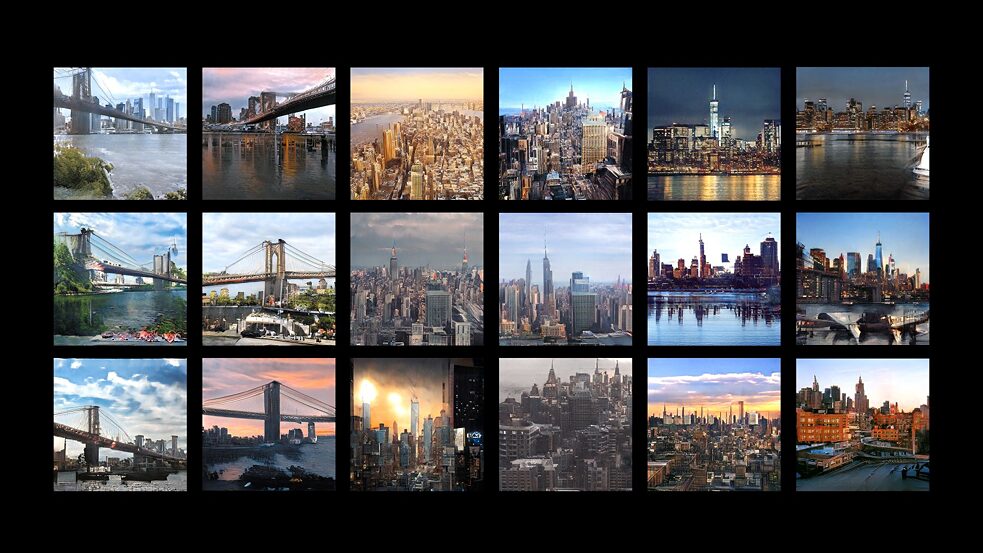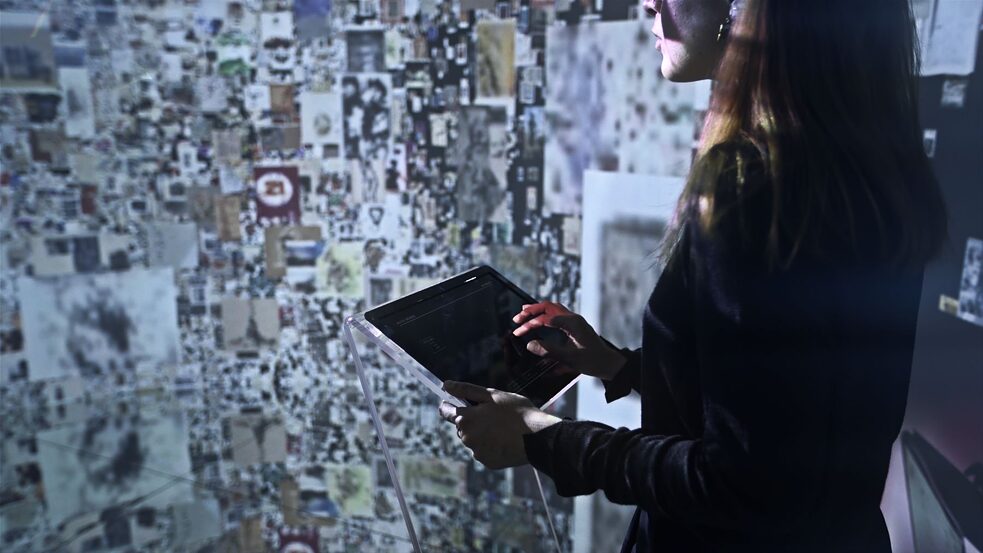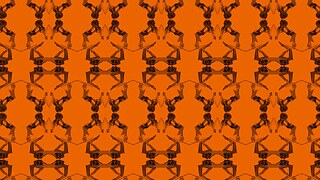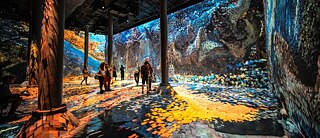Art walks in latent spaces
At the Los Angeles-based Refik Anadol Studio, artists, architects and data scientists collaborate with machine intelligence to rethink the layered meanings of consciousness and space. Pelin Kivrak, the concept developer at RAS, gives an insight into the Studio’s recent work.
 Pelin Kivrak
| © Pelin Kivrak
The question of whether we can talk about art from a non-anthropocentric perspective lies at the heart of recent aesthetic inquiries into our social, neural, ecological and cosmic interconnections. Emergent practices of multimedia artists who work with AI generate a new field of possibilities where complex representational tools are manifested in unconventional art spaces. For the Los Angeles-based Refik Anadol Studio (RAS), these spaces include building facades, interiors of old power plants and public library archives. Following the vision of the multimedia artist Refik Anadol, RAS explores the potential for intersections of art and artificial intelligence through live audio/visual performances, data sculptures and immersive installations.
Pelin Kivrak
| © Pelin Kivrak
The question of whether we can talk about art from a non-anthropocentric perspective lies at the heart of recent aesthetic inquiries into our social, neural, ecological and cosmic interconnections. Emergent practices of multimedia artists who work with AI generate a new field of possibilities where complex representational tools are manifested in unconventional art spaces. For the Los Angeles-based Refik Anadol Studio (RAS), these spaces include building facades, interiors of old power plants and public library archives. Following the vision of the multimedia artist Refik Anadol, RAS explores the potential for intersections of art and artificial intelligence through live audio/visual performances, data sculptures and immersive installations.RAS operates in a distinct area of visual experience that builds upon machine learning and synesthesia in art. The Studio’s works utilize various computational design methods, such as architectural projection mapping, custom algorithms and generative adversarial networks (GANs) that train machine intelligence with the purpose of processing vast datasets of visual and textual knowledge. Since its inception in 2014, RAS has been seeking to uncover new dialogic relationships between imagination and physicality, self and environment, technology and history by drawing attention to the growing virtual archives of individual, collective, institutional or artificial memories.
Sense of a space
Most of the Studio’s experiments with memory occur on a material level, either in the form of revealing interconnections between archival materials or looking inside the human brain. In 2017, for instance, RAS created a unique installation in Istanbul called Archive Dreaming, in collaboration with Google’s Artists and Machine Intelligence program. The Studio used machine learning algorithms to transform more than 1.5 million documents from Istanbul’s SALT Research Center’s archives of urban life and art history in Turkey into an interactive multimedia installation.
 Images of New York used in Refik Anadol's "Machine Hallucination" installation
| © Refik Anadol Studio
In late 2019, RAS presented Machine Hallucination a video installation that utilized 113 million images of New York, the largest collective urban memory database ever used in an artwork. Refik Anadol also recently announced the Studio’s collaboration with the UCLA Neuroimaging Collective to build a dynamic network that will shed further light on the Lifespan Human Connectome Project’s (HCP) cutting-edge research into the architecture of the human brain. The MRI data that HCP collects from people between ages 0-100+ covers structure, connectivity and function of the brain across many modalities, including emotion, learning, musicianship and remembering. By training machine-learning algorithms on the human MRI data sets, Anadol will encourage artificial intelligence to make its own patterns, resulting in a free-form imagining of human neural networks.
Images of New York used in Refik Anadol's "Machine Hallucination" installation
| © Refik Anadol Studio
In late 2019, RAS presented Machine Hallucination a video installation that utilized 113 million images of New York, the largest collective urban memory database ever used in an artwork. Refik Anadol also recently announced the Studio’s collaboration with the UCLA Neuroimaging Collective to build a dynamic network that will shed further light on the Lifespan Human Connectome Project’s (HCP) cutting-edge research into the architecture of the human brain. The MRI data that HCP collects from people between ages 0-100+ covers structure, connectivity and function of the brain across many modalities, including emotion, learning, musicianship and remembering. By training machine-learning algorithms on the human MRI data sets, Anadol will encourage artificial intelligence to make its own patterns, resulting in a free-form imagining of human neural networks.On a more conceptual level, Anadol claims that RAS speculates a sense of latent space akin to the processes of dreaming and hallucinating that happens after memories become condensed and categorized. Latent space in machine learning is where unobservable connections between data points become closer when compressed. In other words, the works of RAS do not merely allude to dreams by putting forward a series of hypnotic and abstract visual metaphors that are open to interpretation; they indeed show us what would happen if a machine becomes able to emulate the human mind’s subconscious processes. For example, in the Archive Dreaming project, the installation entices the audience into novel modes of sensory experience by looking at images hallucinated by the machine based on the real, material archives that it has previously “seen.” What the audience’s agency brings to this latent space is imbued with another set of – more subjective – codes: narrative, mythical, linguistic, historical, and cultural interpretive tools to encode the accidental yet provocative imagery that an artificial mind presents to them.
 A member of the public tests out Refik Anadol's "Archive Dreaming" project
| © Refik Anadol Studio
As a multi-channel experience, Archive Dreaming brings a self-regenerating element of surprise to the viewers and offers a new form of sensational autonomy through cybernetic serendipity. When we train the machine mind to classify vast data sets according to their structural similarities that are invisible to the untrained eye, we find ourselves in a hidden process of deep learning that serves the purpose of finding patterns. But what does this latent space of compressed data enclose beyond what is sensible and perceivable? How do AI-induced representations offer an avant-garde form of cartographic aesthetics in multi-dimensional spaces?
A member of the public tests out Refik Anadol's "Archive Dreaming" project
| © Refik Anadol Studio
As a multi-channel experience, Archive Dreaming brings a self-regenerating element of surprise to the viewers and offers a new form of sensational autonomy through cybernetic serendipity. When we train the machine mind to classify vast data sets according to their structural similarities that are invisible to the untrained eye, we find ourselves in a hidden process of deep learning that serves the purpose of finding patterns. But what does this latent space of compressed data enclose beyond what is sensible and perceivable? How do AI-induced representations offer an avant-garde form of cartographic aesthetics in multi-dimensional spaces?
Latency as an aesthetic category
The question of what a given space can allow us to reconstruct is more interesting than simply re-constructing a space, physically or metaphorically. Whether in archives of memory, image, text, or unclassified virtual knowledge, the possibility of coincidental interconnections point to a hidden space that is not always accessible through the existing structures and the cognitive functions of the human mind or the AI alone. In many interviews and lectures, and the TED Talk that he gave earlier this year, Anadol dwells on the idea of visualizing the essentially hidden latent space of the human mind by simulating it in “the mind of a machine.”
In celebration of the Los Angeles Philharmonic’s centennial season recently, RAS developed a unique machine intelligence approach to the orchestra’s digital archives to transform the building’s memories into a public art installation, projected onto the exterior of Frank Gehry’s Walt Disney Concert Hall. The dynamic public art piece, WDCH Dreams, displayed data-driven, non-linear patterns based on a data universe created by the LA Phil’s 100-year history and thus gave a metaphoric consciousness to the overlapping spaces of imagination that the iconic building held together. Like Archive Dreams, this project was an important milestone in the Studio’s still ongoing investigations into the elusive process of memory retrieval by rescaling the scope of the inquiry from the individual to the institutional and mapping the results, literally, on the façade of the institution’s building. In addition to immersing the audience in a mesmerizing light spectacle employing 42 large-scale projectors, WDCH Dreams launched an advanced speculative space for the aesthetic potentials of such representations of latency.
In her introduction to Casey Reas’ book Making Pictures with Generative Adversarial Networks, Nora N. Khan writes that artistic experiments with code create a “subjective, interpretive space” for the viewer where the method and the system are less important than the possibilities of this critical space. The artist/architect of this unique practice, according to Khan, makes “space” for a set of potential aesthetic choices. At RAS, these choices end up producing AI-driven “latent cinema” experiences – a term coined by Anadol – in which the buildings, sculptures, images of nature or even musical notes recreate themselves in unpredictable ways, as if yearning for a non-algorithmic autonomy. Just like “the future of AI needs human intelligence” – a quote from Thomas Ramge – contemporary artists like Refik Anadol need AI to find themselves in a latent space of countless choices to simultaneously generate and fulfill new expectations from media arts.
Learn more about Pelin Kivrak's views on the future of creative AI here.

